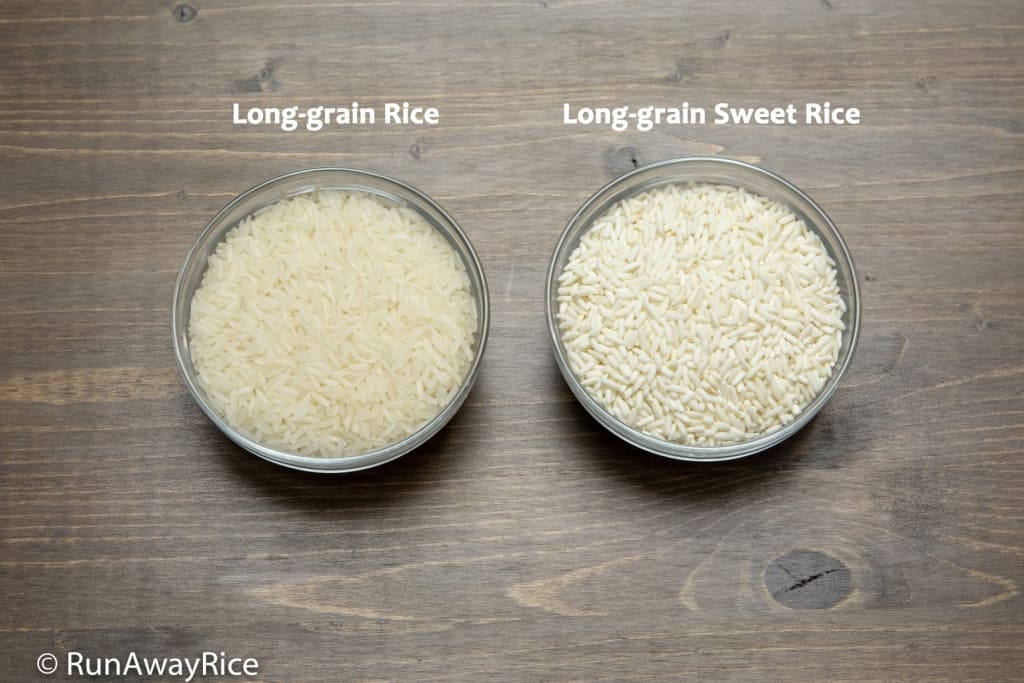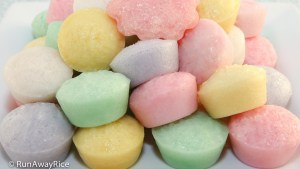Rice Flour vs. Glutinous Rice Flour – What are the Differences? I get this question a lot, and so, I am sharing this post to explain the differences between Rice Flour and Glutinous Rice Flour, the common brands available, how they are used in cooking, and when they can be substituted in recipes. Also, to help you get familiar with these flours, I am sharing some of my favorite recipes using Rice Flour and Glutinous Rice Flour. You can make some yummy dishes and explore these unique ingredients for yourself.

Rice Flour vs. Glutinous Rice Flour – Subtle Name Difference
Rice Flour is ground from long-grain or medium-grain white rice. This rice is the type we commonly eat and make in our rice cookers. The rice grains are typically opaque.
Glutinous Rice Flour is ground from long-grain or short-grain sweet white rice and is also called Sweet Rice Flour. Sweet rice grains are typically solid white.
Both flours are gluten-free which make them wonderful alternatives to wheat flour. “Glutinous” refers to the sticky and gluey consistency of the cooked flour rather than containing glutens. The name can be misleading because Glutinous Rice Flour is actually gluten-free.
Rice Flour vs. Glutinous Rice Flour – Texture, Taste and Weight
Rice Flour and Glutinous Rice Flour are made from white rice, and so, are white in color. Both are finely milled flours with a powdery texture.
Both Rice Flour and Glutinous Rice Flours are neutral tasting before and after cooking. Even though Glutinous Rice Flour is often called Sweet Rice Flour, it is not sweet at all.
1 cup Rice Flour and 1 cup Glutinous Rice Flour weigh about the same, approximately 4.6 ounces (130 grams).
Rice Flour vs. Glutinous Rice Flour – Types and Brands
The common Asian grocery store brand for Rice Flour is the Erawan (Elephant) brand. This Rice Flour is milled from long-grain rice and packaged in a 1 pound (454 grams) plastic bag. Note the “Rice Flour” is in red lettering.
The common Asian grocery store brand for Glutinous Rice flour is also the Erawan (Elephant) brand. It’s milled from long-grain sweet rice and packaged in a 1 pound (454 grams) plastic bag. Note the “Glutinous Rice Flour” is in green lettering.
Because the packages are so similar, it’s really easy to mix them up. Here’s a little trick: “R” for red lettering = regular Rice Flour. “G” for green lettering = Glutinous Rice Flour. 🙂
Bob’s Red Mill also makes Rice Flour and Glutinous / Sweet Rice Flour. They can be substituted for the Asian brand flours in most recipes.
Koda Farms makes Mochiko Sweet Rice Flour. This Glutinous Rice Flour is milled from short-grain rice, has a grittier texture and a bit heavier than the Erawan brand when compared cup per cup. 1 cup Mochiko Sweet Rice Flour is approximately 5.3 ounces (150 grams) versus 1 cup Erawan brand which is 4.6 ounces (130 grams).
Rice Flour vs. Glutinous Rice Flour – Culinary Uses
Both Rice Flour and Glutinous Rice Flour are staple ingredients in Asian cuisine. Additionally, these flours have become more popular with the rise of gluten-free diets.
Rice Flour is typically used in making sweet and savory cakes, pastries and noodles.
Rice Flour can be substituted for wheat flour in most bread and cake recipes. However, because of the lack of glutens, additional ingredients such as Tapioca Starch or Potato Starch are usually added to give foods a softer, doughy consistency.
Glutinous Rice Flour becomes very sticky when heated and has a uniquely chewy texture. As such, it’s a common ingredient in dumplings and many Asian desserts. Glutinous Rice Flour also makes an excellent thickener for sauces and gravies.
Both flours have a tendency to separate when combined with water. When using in batters, be sure to stir well to remove any settling before cooking.
Rice Flour and Glutinous Rice Flour are raw flours. They must be cooked completely before eating. Never eat these flours raw.
Rice Flour vs. Glutinous Rice Flour – Substituting in Recipes
In most recipes, unless specifically stated, Rice Flour and Glutinous Rice Flour should not be used interchangeably. The flours have very different textures, cook very differently and yield very different results. Rice flour is closer to wheat flour and yields a cake-like consistency whereas Glutinous Rice Flour yields a sticky and chewy texture suitable for dumplings or foods that don’t require much structure.
If the Rice Flour or Glutinous Rice Flour is a minor ingredient, you can make the following substitutions:
- Substitute Rice Flour for All-Purpose / Wheat Flour (gluten-full) or Sorghum Flour (gluten-free).
- Substitute Glutinous Rice Flour for Tapioca Starch or Potato Starch. These starches aren’t perfect matches but will provide similar chewy and sticky consistency.
If the major ingredient in the recipe is Rice Flour or Glutinous Rice Flour and you purchased the wrong product, don’t proceed with the recipe. It will not work out and you’ll waste your time and ingredients.
Rice Flour vs. Glutinous Rice Flour – Recipes to Try
Rice Flour is a staple ingredient in Asian cuisine and used in both savory and sweet dishes. Depending on the cooking method, foods with rice flour can be both light and delicate and solid and hearty. Below are some of my favorite recipes:
Steamed Rice Cakes / Cow Cakes / Steamed Honeycomb Cakes (Banh Bo Hap)
Honeycomb Cake – Eggless / Vegetarian Recipe (Banh Bo Nuong Chay)
Steamed Coconut Rice Cake with Toasted Shrimp Flakes (Banh Duc Tom Chay)
Savory Steamed Rice Cakes (Banh Beo)
Savory Rolled Cakes (Banh Cuon)
Because of its soft, chewy and sticky texture, Glutinous Rice Flour is a favorite ingredient in desserts and dumplings. The delicious chewy texture is really addicting! Check out the links below for some amazing recipes.
Sticky Rice Balls in Ginger Syrup (Che Troi Nuoc)
Sticky Rice Dumplings (Banh It Tran)
 Steamed Rice Cakes and Pork Roll (Banh Day)
Steamed Rice Cakes and Pork Roll (Banh Day)
If you have additional questions, regarding the differences between Rice Flour vs. Glutinous Rice Flour, share your comments with me below. Thanks for stopping by! 🙂
Tools I Love and Use in My Kitchen














Our ‘red’ package of rice flour lists ingredients as ‘rice, water’. Water?
you soak the rice in water to soften it for grinding into flour
Hello Trang! Thanks for such a nice explanation. I wanted to ask, can I use glutinous rice flour for making Garaetteok (the rice cakes used for tteokbokki)?
Thanks alot in advance!
Trang – thanks so much for this terrific explanation. I got a new deep fryer and want to try rice flour mixed with regular flour and other ingredients to make a veggie fry batter. I’ve had them done this way and they were amazing so I’m no longer confused about the rice flours and think I can figure out the batter. Thanks again and I love your site.
Hi Trang, I really enjoyed this article explaining the differences! Thank you. We share the same philosophy about not using MSG & many processed seasonings in Asian food. Love what you’re doing.
Thank you! This really helped me!
I dust my bread dough with rice flour to make it easier to handle. Is there any difference between regular and glutinous rice flour in performing this function?
For a dusting on bread dough, there’s little difference.
Hi I am thinking using a ratio of both rice flour to make hofun the current ratio using rice and potato starch is 25% of potato starch for 100% rice flour, can I use sweet rice flour same ratio?
I found this out the hard way. Had both glutenous rice flour and what was labeled as “sweet rice flour” in my pantry. Tried both and both times got the same result – a texture more like Daifuku than sweet rice cake. Ran to H-Mart the next day to get the correct kind of flour and finally made a perfect sweet rice cake the way it was supposed to be made.
I just used glutenous rice flour for my Christmas cake. Disaster. First time making Christmas cake. It’s all chewy and gummy inside. I didn’t know.